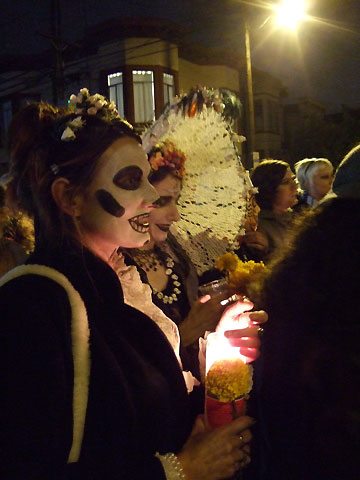
I live in San Francisco’s Mission district, a neighborhood teeming with Mexican and Latin American immigrants, where Dia de Los Muertos gets honored with a fantastic parade and exhibit of altars in Garfield Park. During a pre-parade party at a friends house last night, I met a woman who teaches studio art as an adjunct at Stanford and UC Santa Cruz. We had a lively conversation, which quickly turned to the use of digital images in the classroom (don’t all cocktail conversations?)… and her frustration with said topic. Since she mainly teaches contemporary sculpture, she finds it extremely difficult to get her hands on anything worth projecting in digital form. She tried ARTstor at Stanford, but claims that the interface confused her to a degree that she just gave up. I oracled that I was certain her local art librarian would be delighted to show her the ropes, and she acknowledged how wonderful librarians are once you take the time to talk to them. More frustration: even if she can find an image of a sculpture, it usually doesn’t quite show the angle of the piece bringing out the particular feature she’d like to discuss. She also mentioned that a slide projector on eBay was about $40, and she just bought one. I’d claim this is a user we should strive to serve better!
All of this caused flashbacks of the conversations me and some of my program colleagues had with faculty at Stanford, UC Berkeley and University of Southern California a couple of years ago, and it also reminded me that there are two brand-new studies in this area which I still haven’t gotten around to digesting yet. A CLIR/Rice University report on Art History and Its Publications in the Electronic Age states as its number 1 recommendation:
Organize a campaign to break down barriers to access and distribution of images, in all media and at affordable prices, for scholarly research and publication.
While this recommendation speaks to the availability of digital images, a report commissioned by NITLE and Wesleyan University (based on four hundred survey responses plus three hundred individual interviews with faculty / staff at 33 colleges and universities), authored by David Green, makes its number 1 recommendation faculty tools for enhanced management and sharing of the images:
Develop and share tools and services to assist faculty in organizing, cataloging and managing their personal digital collections, in a user-centered content model.
The little I have read of both reports makes me want to read more (and I hope I managed to wet your appetite as well), and it gives me hope that at another cocktail party in the not-too-distant future, I’ll find the faculty members present more impressed with the image resources available to them.



